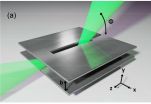(Press-News.org) BLOOMINGTON, Ind. -- A study three years ago sparked a medical mystery when it revealed a part of the brain not found in any present-day anatomy textbooks.
Recently, Indiana University computational neuroscientist Franco Pestilli and an international research team published an article in the journal Cerebral Cortex that suggests this missing part of the brain may play an important role in how we understand the world -- despite getting "lost" for more than a century.
A long flat bundle of nerves called the vertical occipital fasciculus, or VOF, the structure appeared in textbooks on the brain for about 30 years around the end of the 19th century, then mysteriously dropped out of sight completely. Pestilli was also part of the team that first traced this missing brain structure to an 1881 publication by Carl Wernicke, a German-Austrian neuroanatomist.
"Our new study shows that the VOF may provide the fundamental white matter connection between two parts of the visual system: that which identifies objects, words and faces and that which orients us in space," said Pestilli, senior author and assistant professor in the College of Arts and Sciences' Department of Psychological and Brain Sciences, whose work on the collaborative project began as a research associate at Stanford University.
"The structure forms a 'highway' between the lower, ventral part of the visual system, which processes the properties of faces, words and objects, and the upper, dorsal parietal regions, which orients attention to an object's spatial location," he added.
The first researcher on the paper was Hiromasa Takemura of the Center for Information and Neural Networks in Japan.
Based upon where the VOF terminates in the brain's cortex, Pestilli said the VOF might play a critical role in the brain's visual system, coordinating information transmission between brain areas important for "where we see" and "what we see."
In a long-standing debate, neuroscientists have argued the degree to which these two parts of the visual system function separately. The new study suggests that the regions work "hand-in-glove" to coordinate the body's movement in relation to people and objects around it.
There are "countless examples" that reflect how the two functions are intertwined, Pestilli said. Reaching for your keys, putting on your hat, driving to work each morning -- all require this what/where coordination. So does reading words on a page, which demands moving one's eyes with respect to the words and letters.
What happens when this "what/where" coordination fails? Pestilli points to the title character in the late neurologist and writer Oliver Sacks' "The Man Who Mistook His Wife for a Hat," who, when asked to get his hat and put it on, tries to pick up his wife's head to put it on his own.
In this strange disconnect between an object and its location, Sacks recognized the effect of a tumor or degeneration afflicting the patient's visual system. The problem may have specifically affected the functioning of the VOF, Pestilli said, speculating on the symptoms of Sacks' patient.
But how did an entire anatomical structure in the brain suddenly go missing in the first place? The answer may be scientific rivalry.
In their earlier paper, Pestilli and collaborators attributed the VOF's disappearance to competing beliefs among 19th-century neuroanatomists. In contrast to Wernicke, Theodor Meynert, another prominent scientist in Germany, never accepted the new structure due to his belief that all white matter pathways ran horizontally. Over time, the VOF faded into obscurity.
In addition to contributing to the rediscovery and function of the VOF, Pestilli's work is also helping map other parts of the human brain in unprecedented detail, using state-of-the-art neuroimaging and computational methods. This work will not only contribute to a deeper knowledge of the human brain -- such as how variations in brain structures relate to behavioral differences among individuals -- but will also strengthen the university's other investigations into complex networks, including brain connectivity, primarily within the recently established IU Network Science Institute.
"This new study really contributes to our understanding of how two important parts of the brain communicate," said Brian Wandell, a co-author at Stanford, "painting a picture of the brain that is highly interconnected."
INFORMATION:
In addition to Takemura and Wandell, collaborators on the new study were Ariel Rokem of the University of Washington, Jonathan Winawer of New York University and Jason Yeatman of the University of Washington. Pestilli and colleagues' earlier paper on the lost history of the VOF was conducted at Stanford. Collaborators on the earlier paper were Aviv Mezer, Rokem, Wandell, Kevin Weiner and Yeatman.
Support for the new study was provided by the IU College of Arts and Sciences, National Institutes of Health, National Science Foundation and the Japanese Society for the Promotion of Science.
Researchers at Cardiff University have devised a way of increasing the yield of biodiesel by using the waste left over from its production process.
Using simple catalysis, the researchers have been able to recycle a non-desired by-product produced when biodiesel is formed from vegetable oil, and convert this into an ingredient to produce even more biodiesel.
It is believed this new process will have significant environmental benefits by improving the yield of biodiesel in a sustainable way that doesn't require the use of additional fossil fuels, and could potentially ...
PROVIDENCE, R.I. [Brown University] -- Terahertz radiation could one day provide the backbone for wireless systems that can deliver data up to one hundred times faster than today's cellular or Wi-Fi networks. But there remain many technical challenges to be solved before terahertz wireless is ready for prime time.
Researchers from Brown University have taken a major step toward addressing one of those challenges. They've developed what they believe to be the first system for multiplexing terahertz waves. Multiplexers are devices that enable separate streams of data to ...
(SACRAMENTO, Calif.) -- Vitamin D insufficiency among the elderly is highly correlated with accelerated cognitive decline and impaired performance, particularly in domains such as memory loss that are associated with Alzheimer's disease and dementia, researchers with the UC Davis Alzheimer's Disease Center and Rutgers University have found. The effect is "substantial," with individuals with low vitamin D declining at a rate three times faster than those with adequate vitamin D levels.
The researchers said their findings amplify the importance of identifying vitamin D ...
Vitamin D insufficiency was associated with faster decline in cognitive functions among a group of ethnically diverse older adults, according to an article published online by JAMA Neurology.
In addition to promoting calcium absorption and bone health, vitamin D may influence all organ systems. Both the vitamin D receptor and the enzyme that converts 25-hydroxyvitamin D (25-OHD) to the active form of the vitamin are expressed in all human organs, including the brain. Thus, research has increasingly examined the association between vitamin D status and a variety of health ...
To encourage hospitals to improve quality of care, Medicare penalizes those with higher than expected rates of readmission within 30 days of discharge. The logic behind the penalties is that if patients receive high quality care, including proper discharge planning, they should be less likely to end up back in the hospital.
This seems straightforward, but it turns out that the social and clinical characteristics of a hospital's patient population that are not included in Medicare's calculation explain nearly half of the difference in readmission rates between the best- ...
Black children were less likely to receive any pain medication for moderate pain and less likely to receive opioids for severe pain than white children in a study of racial disparities in the pain management of children with appendicitis in emergency departments, according to an article published online by JAMA Pediatrics.
Racial and ethnic differences in the emergency department (ED) management of pain have been described, with lower rates of opioid prescription for black and Hispanic patients than for white patients. However, there are fewer studies in children. Appendicitis ...
The largest population genome sequencing effort to date is published today in Nature. A series of papers describing resources and application of the data is published at the same time in Nature, Nature Genetics, Bioinformatics and Nature Communications.
Rare genetic variants are changes in DNA that are carried only by relatively few people in a population. The UK10K study was designed to explore the contribution of these rare genetic variants to human disease and its risk factors.
"The project has made important new contributions towards describing the role of rare ...
This news release is available in Spanish.
Final OS and subgroup analysis of the pivotal study SAR-3007
First interim results of the Y-IMAGE prospective study showing real-world data for trabectedin in advanced soft tissue sarcoma (STS)
Clinical data of trabectedin in translocated-related sarcomas, and in advanced leiomyosarcomas and liposarcomas
Early clinical studies of PM1183 in combination with paclitaxel or cisplatin show a synergistic activity
Madrid, September 14, 2015: PharmaMar announces that it will show new data from clinical pivotal ...
This news release is available in French. We have known for some years that Alzheimer's disease is characterised by two types of lesions, amyloid plaques and degenerated tau protein. Cholesterol plays an important role in the physiopathology of this disease. Two French research teams (Inserm/CEA/University of Lille/University of Paris-Sud ) have just shown, in a rodent model, that overexpressing an enzyme that can eliminate excess cholesterol from the brain may have a beneficial action on the tau component of the disease, and completely correct it. This is the first ...
WASHINGTON, Sept. 14, 2015 -- It's a condition that turns the lives of millions of Americans upside-down: addiction. Whether it's alcohol, drugs, food or gambling, it can ruin lives. In support of National Recovery Month, which calls attention to substance abuse issues and treatment services, Reactions takes a look at the chemistry behind addiction. Check it out here: https://youtu.be/C6I3CHhBGeQ.
Subscribe to the series at http://bit.ly/ACSReactions, and follow us on Twitter @ACSreactions to be the first to see our latest videos.
INFORMATION:The American Chemical ...





